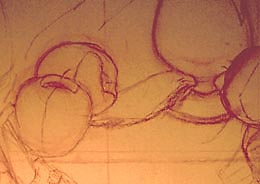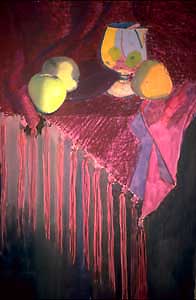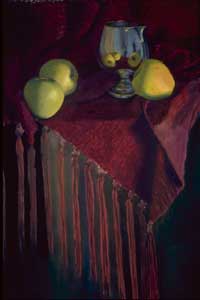
 STAGE 1- The Blueprint
STAGE 1- The Blueprint I arrange my still life objects under artificial lighting and manipulate them until I create dynamic shadows and strong value contrast. Using rough sanded paper, I sketch my set-up using a light colored pastel pencil. At this point, I want to establish the composition, making sure the placement of the shapes is balanced and aesthetically pleasing. I can continue to redraw until I get it the way I want so my 'preliminary' sketches become my painting and I do not need to transfer my drawing to another paper. |
 STAGE 2 - The Foundation
STAGE 2 - The Foundation For the underpainting I use a thin oil paint and turpentine wash which stains the paper without filling in the tooth. Rather than a one-color underpainting, I prefer to underpaint each of the various elements with what I determine will be the most appropriate foundation for that particular item. Sometimes I use the complement of the color going on top, sometimes a darker value of the same color; sometimes cool under warm or the other way around. I also begin to establish the values and indicate the shadow areas. I am then ready to begin applying the pastel, as shown at the top where I have started building the texture of the cloth. |
 STAGE 3 - The Construction
STAGE 3 - The Construction Starting with hard/medium pastels, I begin the process of laying in color. I generally work from the top of the paper to the bottom because it is less messy. I use every stroke technique imaginable; sometimes scumbling, hatching, cross hatching, scribbling and blending with the sides and tips of the pastel sticks, creating strong contrasts in texture, temperature and value. I often use pastel pencils to soften edges and to blend. If any areas become overworked, or need to be altered, I brush off the pastel dust and apply some turpentine, getting back down close to the original surface. |
 STAGE 4 - Finishing Touches, Finished Painting
STAGE 4 - Finishing Touches, Finished Painting After being immersed in any painting for a long period of time, I often find myself unable to see it with an objective eye, so I put it away for a few days. When I look at it again, I can tell more clearly if it is finished and what else, if anything, needs to be done: perhaps a brighter highlight utilizing the very soft pastels, or maybe something needs to be pulled forward or pushed back. When I'm satisfied, I take it outside and beat it on the back to remove the loose pastel dust. This often causes some of the underneath layers to show through and add sparkle to the painting. |
Copyright © 1999 Artshow.com. All rights reserved.
Web Design by Artshow.com
Web pages and artwork at this site may not be duplicated or redistributed in any form without express permission.